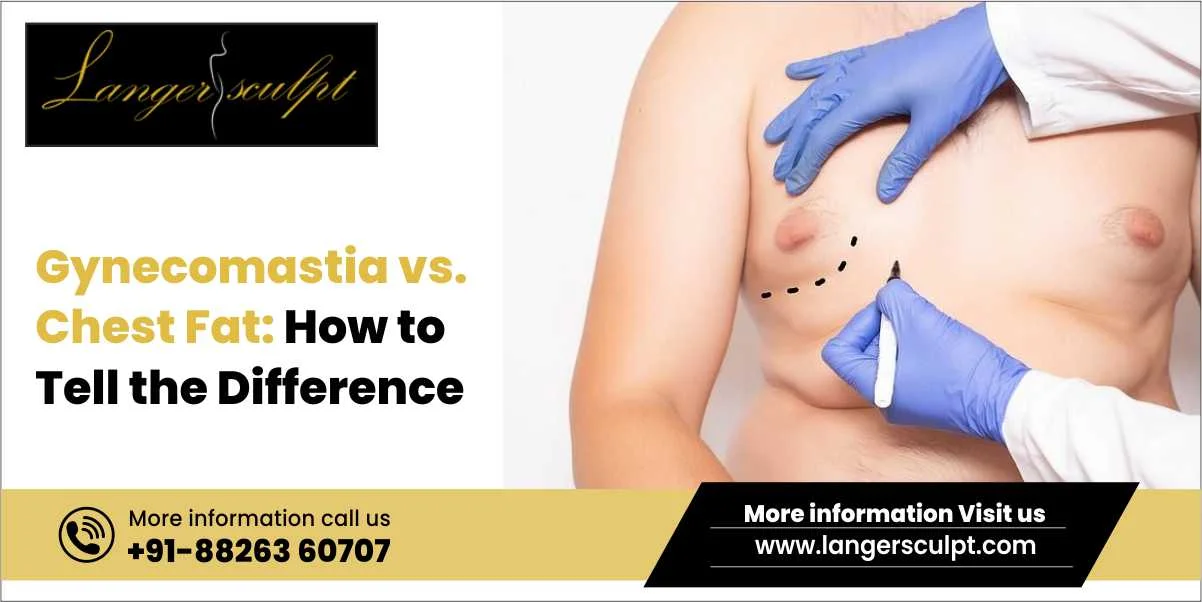

04 Sep, 2025

That fuller chest may leave you thinking whether it is just chest fat or gynecomastia.
Most often, men notice an extra fullness in their chest and find it uncomfortable and confusing.
They ask, “Is this just fat, or is something else going on?”
What may look like a simple weight gain might be gynecomastia. This is a common condition where male breast tissue grows due to hormonal changes.
Though chest fat and gynecomastia may look similar, they have very different causes and solutions.
It is like one may respond to exercise and diet, while the other may not budge, even after putting in so much effort in exercising.
It is crucial to understand which one you’re dealing with, Gynecomastia or Chest Fat, to learn the cause and the ways to fix it.
In this blog, we will learn about Gynecomastia vs Chest Fat, along with how to spot the differences and what you can do about them.
Gynecomastia means an increase in breast tissue in men.
It differs from chest fat, typically made up of soft fatty deposits; gynecomastia involves actual gland tissue growth.
Generally, this occurs when there is an imbalance between two key hormones — testosterone and estrogen.
These are two of the main hormones that men naturally produce. However, when estrogen levels rise or testosterone levels drop, it may lead to this tissue growth.
It is common at different stages of life. Teenagers may notice it during puberty, when hormone levels fluctuate. However, older men may develop it as natural testosterone levels decline.
In some cases, it can also occur if certain medications, alcohol use, or health conditions affect hormone balance.
It typically feels like a firm or rubbery swelling right under the nipple. It can be tender or even slightly painful.
Thus, it often doesn’t shrink with exercise or weight loss. While it’s usually harmless, it can affect confidence and often requires medical advice if it is persistent or grows.
Chest fat, also known as “pseudogynecomastia,” is a fat accumulated in the chest area.
It typically develops as part of overall weight gain when excess calories are stored as fat across the body, including the chest. This fat feels soft, evenly spread out, and doesn’t form a distinct lump under the nipple.
Men often notice it along with fat in other areas, such as the belly, sides, or thighs. Exercising with healthy eating can help remove this type of fat.
Undoubtedly, both cases can cause chest enlargement, but they differ from each other. Here are the key differences:
| Feature | Gynecomastia | Chest Fat |
| What it is | Growth of actual breast gland tissue due to hormone imbalance | Fat deposits in the chest caused by overall weight gain |
| Feel/Texture | Firm or rubbery lump, usually under the nipple | Soft and evenly spread out |
| Pain or Tenderness | Sometimes tender or sensitive to touch | Usually painless |
| Location | Concentrated directly beneath the nipple | Spread across the entire chest area |
| Response to Exercise | Usually does not shrink with diet or workouts | Typically reduces with weight loss and strength training |
| Other Signs | May appear at puberty, middle age, or with certain medicines | Often occurs along with belly fat or love handles |
If you want to check if you have Gynecomastia or chest fat at home, here is how you can do it:
These may be a few tips to check at home; however, it is crucial to consult a doctor for an accurate diagnosis.
While chest changes are often harmless. Still, it is best to seek medical advice if you notice:
The fixes to each of them vary. Here is what they look like:
If you are diagnosed with gynecomastia, then you may need:
It is crucial to check the cause behind your chest fat, as not every enlarged chest is “extra fat.” Gynecomastia and chest fat may look similar, but they differ in cause and treatment.
Understanding what you are dealing with can help you see the right solution and regain your confidence in how you look and feel.
No. Since gynecomastia is gland tissue, and not fat, it won’t shrink with workouts. If your chest size doesn’t change after losing weight, it is more likely that you have gynecomastia.
Chest fat feels soft and reduces with weight loss, while Gynecomastia feels firm under the nipple and doesn’t shrink even with diet or exercise.
In most cases, it is harmless and only affects appearance. However, if the lump grows, feels hard, or causes pain, one must see a doctor.
Yes. Hormonal changes during puberty often cause temporary gynecomastia, but it usually disappears naturally within months.
Yes, being overweight mainly causes chest fat.